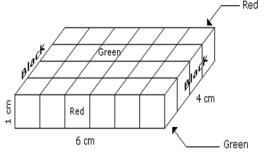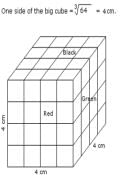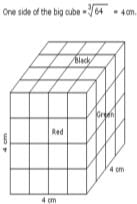Test: Cubes and Dice- 2 - CUET Commerce MCQ
15 Questions MCQ Test - Test: Cubes and Dice- 2
A cuboid shaped wooden block has 6 cm length, 4 cm breadth and 1 cm height. Two faces measuring 4 cm × 1 cm are coloured in black. Two faces measuring 6 cm × 1 cm are coloured in red. Two faces measuring 6 cm × 4 cm are coloured in green. The block is divided into 6 equal cubes of side 1 cm (from 6 cm side), 4 equal cubes of side 1 cm (from 4 cm side).
How many cubes will remain if the cubes having black and green coloured are removed?
A cuboid of dimensions (6 cm × 4 cm × 1 cm) is painted black on both the surfaces of dimensions ( 4 cm × 1 cm) green on the surfaces of dimensions (6 cm × 4 cm). and red on the surfaces of dimensions (6 cm × 1 cm). Now the block is divided into various smaller cubes of side 1 cm. each. The smaller cubes so obtained are separated.
How many cubes will be formed?
A cuboid of dimensions (6 cm × 4 cm × 1 cm) is painted black on both the surfaces of dimensions ( 4 cm × 1 cm) green on the surfaces of dimensions (6 cm × 4 cm). and red on the surfaces of dimensions (6 cm × 1 cm). Now the block is divided into various smaller cubes of side 1 cm. each. The smaller cubes so obtained are separated.
What should be the number opposite to 4?






The figure (X) given below is the unfolded position of a cubical dice. In each of the following questions, this unfolded figure is followed by four different figures of dice. You have to select the figure which is identical to the figure (X).
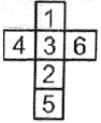
All the opposite faces of a big cube are coloured with red, black and green colours. After that, is cut it into 64 small equal cubes. In each of the following questions, select the correct option for the questions asked.
How many small cubes are there where one face is green and other one is either black or red?
All the opposite faces of a big cube are coloured with red, black and green colours. After that, is cut it into 64 small equal cubes. In each of the following questions, select the correct option for the questions asked.
How many small cubes are there with 3 faces coloured?
On the basis of the following figures, you have to tell which number will come in place of ‘?’
(i) 
(ii) 
(iii) 
Choose from the alternatives, the boxes that will be formed when figure (X) is folded:
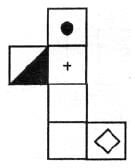
Choose from the alternatives, the boxes that will be formed when figure (X) is folded:

A cube is coloured orange on one face, pink on the opposite face, brown on one face and silver on a face adjacent to the brown face. The other two faces are left uncoloured. It is then cut into 125 smaller cubes of equal size. Now answer the following questions based on the above statements.
How many cubes have all the faces uncoloured?
A cube is coloured orange on one face, pink on the opposite face, brown on one face and silver on a face adjacent to the brown face. The other two faces are left uncoloured. It is then cut into 125 smaller cubes of equal size. Now answer the following questions based on the above statements.
How many cubes are coloured orange on one face and have the remaining faces uncoloured?
A cube is painted red on two adjacent surfaces and black on the surfaces opposite to red surfaces and green on the remaining faces. Now the cube is cut into sixty four smaller cubes of equal size.
How many smaller cubes have only one surface painted?
A cube is painted red on two adjacent surfaces and black on the surfaces opposite to red surfaces and green on the remaining faces. Now the cube is cut into sixty four smaller cubes of equal size.
How many smaller cubes have less than three surfaces painted?
A cube is painted red on two adjacent surfaces and black on the surfaces opposite to red surfaces and green on the remaining faces. Now the cube is cut into sixty four smaller cubes of equal size.
How many smaller cubes with two surfaces painted have one face green and one of the adjacent faces black or red?


